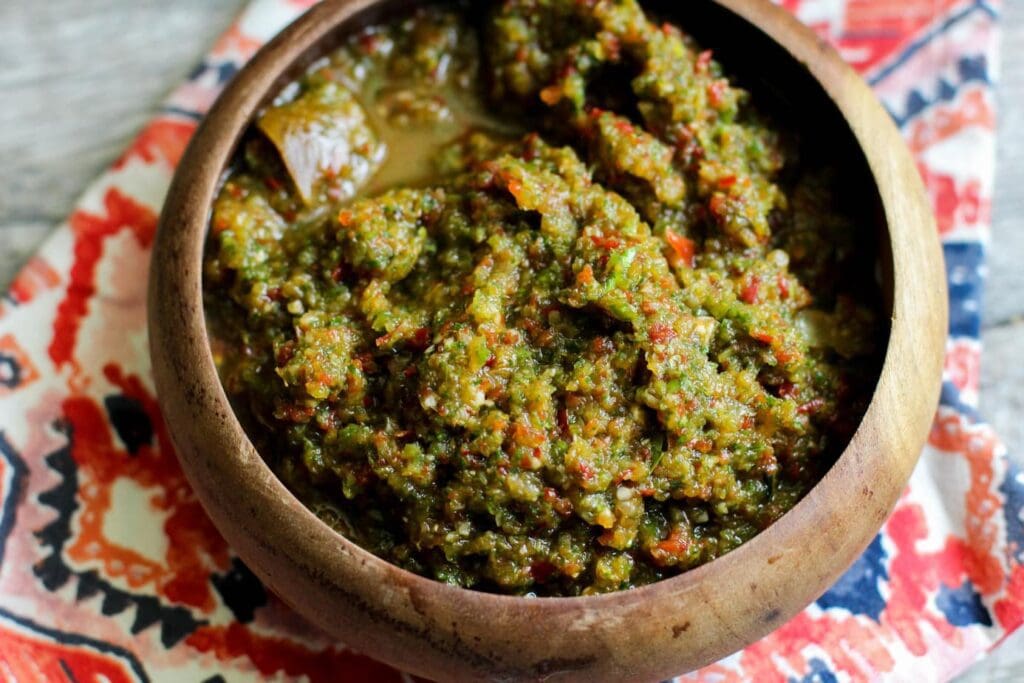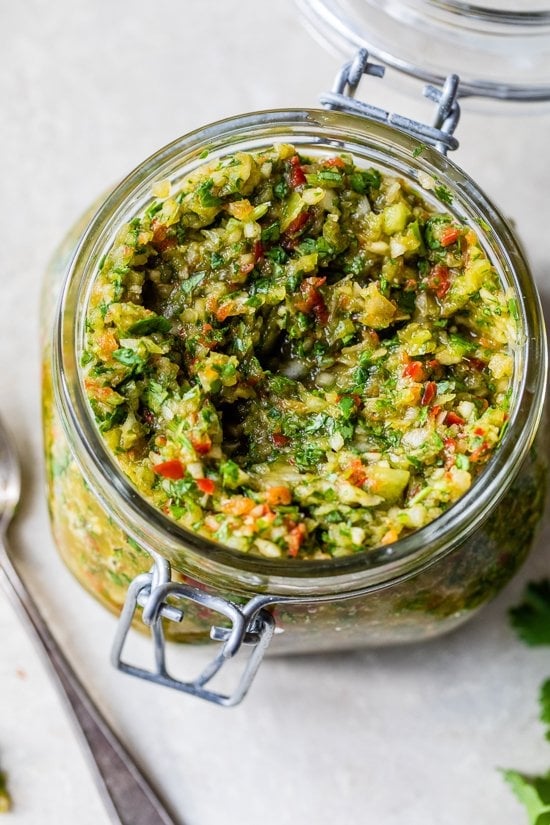Puerto Rican Sofrito is a staple in many Caribbean kitchens. It’s a flavor-packed blend of herbs and vegetables.
Sofrito forms the heart of numerous Puerto Rican dishes. This aromatic base elevates soups, stews, and rice dishes to new heights. Made with fresh ingredients like garlic, onions, peppers, and cilantro, it offers a burst of flavor. Whether you’re new to Puerto Rican cuisine or a seasoned cook, mastering sofrito can transform your cooking.
Its versatility and rich taste make it an essential recipe. Dive into the world of Puerto Rican flavors and discover how this simple blend can make a huge difference. Let’s explore the secrets of making authentic Puerto Rican sofrito.
:max_bytes(150000):strip_icc()/__opt__aboutcom__coeus__resources__content_migration__serious_eats__seriouseats.com__recipes__images__2012__04__20120419-202609-sofrito-b7d73ba5505b4317be0e49e904f00f0b.jpg)
Credit: www.seriouseats.com
Introduction To Sofrito
Sofrito is the heart of Puerto Rican cooking. This aromatic blend of herbs and spices forms the base of many traditional dishes. It’s a vibrant mix of flavors that brings life to any meal. Let’s delve into the world of sofrito and uncover its magic.
Cultural Significance
Sofrito holds a special place in Puerto Rican culture. It’s more than just a cooking ingredient; it’s a symbol of family and tradition. Many Puerto Rican families pass down their sofrito recipes through generations. Each family has its own unique twist, making it a personal touch in every dish. The aroma of sofrito cooking often brings memories of home and family gatherings. It’s a cornerstone of Puerto Rican culinary heritage.
Common Uses
Sofrito is incredibly versatile. It’s used in a variety of dishes:
- Rice: Add sofrito to rice dishes for an instant flavor boost.
- Soups and Stews: It serves as a flavorful base for soups and stews.
- Beans: Stir in sofrito to make beans more delicious.
- Marinades: Use sofrito as a marinade for meats and seafood.
Here’s a quick look at how sofrito enhances different dishes:
| Dish | How Sofrito is Used |
|---|---|
| Arroz con Gandules | Sofrito is mixed into the rice for depth of flavor. |
| Sancocho | Acts as the base for this hearty stew. |
| Habichuelas Guisadas | Sofrito makes the beans rich and savory. |
| Pollo Guisado | Marinades the chicken for tenderness and taste. |
These are just a few examples. The possibilities are endless with sofrito. It’s a must-have in any Puerto Rican kitchen.

Credit: www.veggiejeva.co
Essential Ingredients
Creating an authentic Puerto Rican sofrito begins with gathering the essential ingredients. These ingredients form the base of many Puerto Rican dishes. They provide depth and unique flavor. Let’s dive into the key components you need.
Herbs And Spices
Herbs and spices are the soul of sofrito. They add aroma and taste that define the dish.
- Culantro: This herb is similar to cilantro but with a stronger taste.
- Cilantro: Fresh cilantro adds a citrusy, slightly peppery flavor.
- Oregano: Use dried oregano for a hint of earthiness.
- Bay Leaves: Add these for a subtle depth and aroma.
Vegetables And Aromatics
Vegetables and aromatics are the backbone of sofrito. They provide the bulk and body of the mix.
| Vegetable | Description |
|---|---|
| Green Bell Peppers | Provide a sweet and slightly bitter flavor. |
| Red Bell Peppers | Add a mild sweetness and vibrant color. |
| Onions | Yellow or white onions give a sweet, pungent taste. |
| Garlic | Fresh garlic cloves offer a robust, spicy kick. |
| Aji Dulce Peppers | Small, sweet peppers that add a unique flavor. |
These ingredients make the sofrito rich and flavorful. Chop them finely and blend until smooth.
Preparation Techniques
Creating a delicious Puerto Rican Sofrito requires a few essential preparation techniques. These steps ensure the flavors blend perfectly, giving you that authentic taste. Let’s dive into some key methods.
Chopping And Dicing
The first step in making sofrito is chopping and dicing the ingredients. This includes green bell peppers, onions, garlic, cilantro, and recao leaves. It’s crucial to cut these ingredients into small, even pieces. This helps in blending them smoothly later.
- Use a sharp knife for cleaner cuts.
- Chop the bell peppers and onions into small cubes.
- Mince the garlic finely to release its strong flavor.
- Roughly chop the cilantro and recao leaves.
Blending For Consistency
Once the ingredients are chopped, the next step is blending them for the right consistency. This ensures the sofrito has a smooth texture, ideal for cooking.
- Place the chopped ingredients into a blender or food processor.
- Blend until the mixture is smooth but slightly chunky.
- If the mixture is too thick, add a small amount of water.
- Check the consistency and blend again if needed.
A good sofrito should have a thick, paste-like texture. This makes it easy to store and use in various dishes. The blending process also helps the flavors meld together, enhancing the overall taste.

Credit: latinamommeals.com
Traditional Cooking Methods
Traditional methods are the heart of Puerto Rican cooking. They bring out the rich flavors and create an authentic taste. These methods have been passed down for generations, preserving the essence of Puerto Rican cuisine. Understanding these methods will help you make the perfect sofrito.
Stovetop Preparation
Stovetop preparation is a common method for making sofrito. It involves sautéing the ingredients, which helps in releasing their natural flavors. Here is a simple way to prepare sofrito on the stovetop:
- Heat a pan on medium heat.
- Add a few tablespoons of olive oil.
- Add chopped onions, garlic, and peppers.
- Cook until the onions are translucent.
- Add cilantro and culantro.
- Stir continuously to avoid burning.
- Cook for 10-15 minutes until all ingredients are soft.
Tip: You can store the cooked sofrito in an airtight container in the refrigerator for up to a week.
Using A Mortar And Pestle
Using a mortar and pestle is a traditional method that enhances the flavors. This method crushes the ingredients, releasing their oils and aromas. Follow these steps to prepare sofrito using a mortar and pestle:
- Place chopped garlic and salt in the mortar.
- Crush the garlic until it forms a paste.
- Add chopped onions and peppers.
- Continue to crush until they are well blended.
- Add cilantro and culantro.
- Mix everything until you get a smooth texture.
Tip: The mortar and pestle method takes more time but gives a richer flavor compared to blending.
These traditional methods not only make your sofrito taste better but also connect you to the rich culinary heritage of Puerto Rico.
Regional Variations
Puerto Rican sofrito is a cornerstone of the island’s cuisine. This aromatic blend is used in countless dishes. Yet, its preparation can vary significantly across regions. These differences add depth and uniqueness to the dishes. Let’s explore some regional variations.
North Vs. South
In the north of Puerto Rico, sofrito often includes more herbs. You might find the use of oregano and cilantro prevalent. These herbs provide a fresh and vibrant flavor.
In contrast, the southern regions favor a bolder taste. They incorporate more aji dulce and recao. This gives the sofrito a richer and more complex profile.
| Region | Key Ingredients | Flavor Profile |
|---|---|---|
| North | Oregano, Cilantro | Fresh, Vibrant |
| South | Aji Dulce, Recao | Rich, Complex |
Urban Vs. Rural
Urban areas tend to have a more modern take on sofrito. They use blenders and food processors. This results in a smoother paste. Ingredients may also include non-traditional items like bell peppers.
Rural areas stick to traditional methods. They use a mortar and pestle for a coarser texture. The focus remains on locally grown ingredients. You might find more culantro and garlic in their recipes.
- Urban Sofrito: Smoother, may include bell peppers
- Rural Sofrito: Coarser, relies on traditional ingredients
Health Benefits
Puerto Rican Sofrito is a staple in Puerto Rican cuisine, known for its rich flavors. But, did you know it also offers numerous health benefits? Let’s dive into the nutritional value and natural ingredients of this flavorful mix.
Nutritional Value
Sofrito is packed with essential vitamins and minerals. Here’s a closer look:
| Ingredient | Vitamin C | Vitamin A | Fiber |
|---|---|---|---|
| Bell Peppers | Yes | Yes | Yes |
| Onions | No | Yes | Yes |
| Garlic | No | No | Yes |
| Tomatoes | Yes | No | Yes |
| Cilantro | Yes | Yes | No |
Each ingredient contributes to a balanced diet. Bell peppers and tomatoes are rich in Vitamin C. Onions and garlic provide fiber, essential for digestion. Cilantro offers both Vitamin C and Vitamin A.
Natural Ingredients
Sofrito is made from fresh, natural ingredients. These include:
- Bell Peppers: High in vitamins and antioxidants.
- Onions: Great for heart health and immunity.
- Garlic: Known for its anti-inflammatory properties.
- Tomatoes: Rich in lycopene, good for skin health.
- Cilantro: Helps detoxify the body and improves digestion.
Using fresh ingredients ensures you get the most nutrients. This enhances the health benefits of your meals.
Incorporating sofrito into your dishes can lead to a healthier diet. It adds flavor and nutrition without extra calories.
Incorporating Sofrito In Dishes
Puerto Rican sofrito is a flavorful base made from a blend of vegetables and herbs. It adds depth and richness to many dishes. Below, learn how to incorporate sofrito into your cooking. Discover its magic in soups, stews, rice, and beans.
Soups And Stews
Sofrito elevates the taste of soups and stews. Start by sautéing the sofrito in a pot with some oil. This releases its flavors. Add your choice of broth, vegetables, and proteins.
- Chicken Stew: Sauté sofrito, then add chicken and broth.
- Vegetable Soup: Sauté sofrito, then add mixed veggies and water.
Let the soup or stew simmer until everything is tender. The sofrito will infuse the dish with its rich taste. Each spoonful will be a burst of Puerto Rican flavor.
Rice And Beans
Sofrito is essential in Puerto Rican rice and beans. It provides a savory foundation. Sauté the sofrito in a pot with a bit of oil. Add rice and stir to coat the grains.
- Add water or broth to the rice.
- Bring to a boil, then reduce heat.
- Cover and simmer until rice is tender.
For beans, sauté sofrito in a separate pot. Add your choice of beans and some water. Simmer until beans are soft and flavorful. Serve the rice and beans together for a perfect meal.
Using sofrito in these dishes makes cooking easier. It also ensures that every bite is packed with flavor.
Storing And Preserving
Storing and preserving your Puerto Rican sofrito is crucial for maintaining its vibrant flavors. Proper storage ensures you always have this essential ingredient on hand. Whether you prefer refrigeration or freezing, these tips will help you keep your sofrito fresh and ready to use.
Refrigeration Tips
Refrigerating sofrito is a common and convenient method. Follow these steps to keep it fresh in the fridge:
- Store sofrito in an airtight container to prevent contamination.
- Keep it in the coldest part of the fridge, usually the back.
- Label the container with the date of preparation.
- Use within one week for the best flavor and freshness.
Freezing For Longevity
Freezing sofrito extends its shelf life significantly. Here are some tips for freezing:
- Divide sofrito into small portions using ice cube trays or freezer-safe bags.
- Once frozen, transfer the sofrito cubes or bags to a larger container.
- Label the container with the date of preparation.
- Use frozen sofrito within three months for optimal flavor.
Both refrigeration and freezing offer practical solutions for storing sofrito. Choose the method that suits your cooking routine best. This way, you’ll always have a burst of Puerto Rican flavor ready to enhance your dishes.
Pairing Sofrito With Other Flavors
Puerto Rican sofrito is a blend of herbs, spices, and vegetables. This mix adds depth to many dishes. To enhance its flavor, pair it with other ingredients. Below are some tips to make your sofrito shine.
Complementary Spices
Sofrito has a rich base flavor. Adding complementary spices can elevate your dish. Here are some spices that work well with sofrito:
- Cumin: Adds warmth and earthiness.
- Oregano: Provides a hint of bitterness.
- Paprika: Brings a smoky sweetness.
- Bay Leaves: Introduces a subtle, aromatic note.
Use these spices in moderation. Too much can overpower the sofrito. A balanced approach ensures each flavor shines through.
Balancing Sweet And Savory
Sofrito typically has a savory profile. To balance this, introduce sweet elements. Here are some options:
| Sweet Ingredients | Description |
|---|---|
| Bell Peppers | Sweet and crunchy, they add a fresh bite. |
| Carrots | Natural sweetness that blends well. |
| Sweet Potatoes | Earthy sweetness that complements the savory notes. |
| Honey | Drizzle a small amount for a hint of sweetness. |
Balancing sweet and savory creates a harmonious dish. Experiment with different combinations to find your favorite blend.
Frequently Asked Questions
What Is Puerto Rican Sofrito?
Puerto Rican Sofrito is a flavorful blend of herbs, spices, and vegetables. It’s used as a base for many Puerto Rican dishes.
How Do You Make Puerto Rican Sofrito?
To make Puerto Rican Sofrito, blend green peppers, onions, garlic, cilantro, and culantro. Store it in the refrigerator or freezer.
Can Sofrito Be Frozen?
Yes, Sofrito can be frozen. Store it in ice cube trays or small containers for easy use in recipes.
What Dishes Use Puerto Rican Sofrito?
Puerto Rican Sofrito is used in rice dishes, stews, soups, and beans. It adds a rich, aromatic flavor.
Conclusion
Creating Puerto Rican sofrito at home is simple and rewarding. Its vibrant flavors transform any dish. Fresh ingredients make all the difference. Enjoy sofrito in soups, stews, and more. Share this recipe with friends and family. They’ll love the taste of Puerto Rico.
Experiment with your own variations. Cooking is about creativity and joy. Savor every bite and happy cooking!




